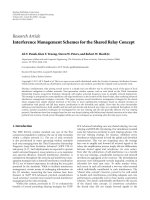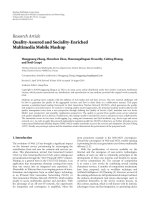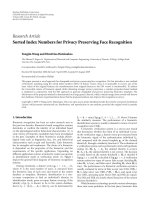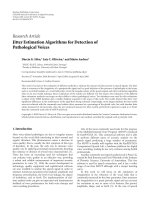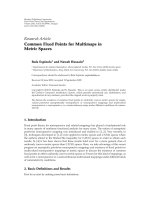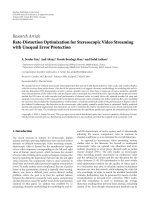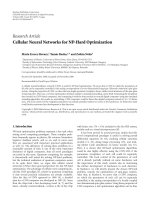Báo cáo hóa học: " Research Article Quality Variation Control for Three-Dimensional Wavelet-Based Video Coders" doc
Bạn đang xem bản rút gọn của tài liệu. Xem và tải ngay bản đầy đủ của tài liệu tại đây (744.69 KB, 8 trang )
Hindawi Publishing Corporation
EURASIP Journal on Image and Video Processing
Volume 2007, Article ID 83068, 8 pages
doi:10.1155/2007/83068
Research Article
Quality Variation Control for Three-Dimensional
Wavelet-Based Video Coders
Vidhya Seran and Lisimachos P. Kondi
Department of Electrical Engineering, State University of New York at Buffalo, 332 Bonne r Hall, Buffalo, NY 14260, USA
Received 15 August 2006; Revised 8 January 2007; Accepted 9 January 2007
Recommended by James E. Fowler
The fluctuation of quality in time is a problem that exists in motion-compensated-temporal-filtering (MCTF-) based video coding.
The goal of this paper is to design a solution for overcoming the distortion fluctuation challenges faced by wavelet-based video
coders. We propose a new technique for determining the number of bits to be allocated to each temporal subband in order to
minimize the fluctuation in the quality of the reconstructed video. Also, the wavelet filter properties are explored to design suitable
scaling coefficients with the objective of smoothening the temporal PSNR. The biorthogonal 5/3 wavelet filter is considered in this
paper and experimental results are presented for 2D+t and t+2D MCTF wavelet coders.
Copyright © 2007 V. Seran and L. P. Kondi. This is an open access article distributed under the Creative Commons Attribution
License, which permits unrestricted use, distribution, and reproduction in any medium, provided the original work is properly
cited.
1. INTRODUCTION
Research in image sequence compression or video coding is a
natural extension of research in image compression/coding.
Beyond the removal of spatial and spectral redundancy in
response to our human visual system (HVS), video coding
exploits further temporal correlation between consecutive
frames. Owing to high similarity between adjacent frames,
efficient video coding significantly relies on effective removal
of temporal redundancy in the source video. Wavelet-based
image coding has enabled not only good compression but
also efficient scalability. Image compression algorithms like
set partitioning in hierarchical trees (SPIHT) [1], embedded
zerotree wavelet (EZW) [2], and JPEG2000 [3] are wavelet-
based and they are known to outperform the discrete-cosine-
transform- (DCT-) based compression techniques for image
coding. As a result, recent research efforts on video coding
were targeted on wavelet-based techniques.
With the increase in demand for video over the Internet,
scalability has become an important issue. A conventional
hybrid coder with closed-loop prediction is not a very effi-
cient method for deriving a scalable codec. For an encoder
to provide scalable bitstream, it must operate without any
prior knowledge about the rate, resolution or temporal level
at which the video sequence will be reconstructed. Hence
the feedback structure that is present in the current hybrid
coders (which is optimal only for one particular rate) makes
scalable compression inefficient. Hence a new method for ex-
ploiting temporal redundancy that eliminates the feedback
loop is required. On the other hand, the 3D transforms pro-
vide a better way of deriving an efficient scalable codec be-
cause no such feedback loop is required. The coder operates
on a current block of frames for temporal and spatial decom-
position. Since the 3D system forms an open-loop system,
the disadvantages associated with traditional hybrid coders
can be avoided. The open-loop coding scheme is currently
an ongoing research problem and wavelet-based coding has
now become a powerful coding option for video in three-
dimensional (open-loop) methods. The main theoretical de-
velopment that promises efficient 3D wavelet-based video
codecs with perfect invertibilty is motion compensated tem-
poral filtering (MCTF) using lifting. The MCTF using lifting
can be performed in two ways.
(1) Two-dimensional spatial filtering followed by tempo-
ral filtering (2D+t) [4–7].
(2) Temporal filtering followed by two-dimensional spa-
tial filtering (t+2D) [8–11].
All current wavelet-based v ideo codecs that employ tempo-
ral filtering exhibit a fluctuation in the PSNR of the recon-
structed frames within a group of frames (GOF). This is true
for both t+2D and 2D+t schemes. The distortion fluctuation
2 EURASIP Journal on Image and Video Processing
is more pronounced with longer filters and is undesirable at
low-bit rates. Most of the coders aim at optimizing the aver-
age PSNR, disregarding the fluctuation in the image quality
across the GOF. The distortion fluctuation inside a GOF can
be in the order of 0.5–4 dB. This may lead to annoying flick-
ering effects and poor visual quality. It is well known that
the average PSNR for the whole video sequence alone is not
an adequate indicator of subjective video quality. Hence the
fluctuation in the image quality across the GOF should be ad-
dressed while optimizing the 3D wavelet coder performance.
The distortion fluctuation considered in this paper is due to
the temporal filter characteristics and is present even if the
temporal filtering is not motion compensated. For MCTF,
the distortion fluctuation also depends on the motion model
[12–15].
The problem of significant variation in the quality of
the reconstructed video has been identified by few designs
[16, 17] for the motion compensated temporal prediction
case. In [16], a design for controlling the distortion variation
is proposed for the unconstrained motion compensated tem-
poral prediction [18]. The distortion of each decoded frame
is expressed as a function of the distortions of the decoded
reference frames at the same temporal level. A control pa-
rameter is set and by varying the control parameter, tradeoffs
between the average PSNR within the GOF and the decoded
PSNR fluctuation are achieved. In [17], the quality fluctu-
ation control is treated as a quadratic programming prob-
lem based on the distortion analysis for MCTF-based video
coding.
Our work aims at exploring the MCTF filter properties
and we present a complete analysis of the filter and mathe-
matical derivations. Based on the mathematical derivations
and the experimental results, the solution for controlling the
quality variation is achieved. The proposed methods are ap-
plicable to any motion model and can be directly extended
to any temporal filter. The reduction in the average PSNR is
also very small.
The temporal wavelet filter properties are known to be a
major factor contributing to distortion fluctuation. The tem-
poral distortion fluctuation is due to different filter synthesis
gains for even and odd frames [ 19]. In this paper, we propose
two novel methods to control the distort ion fluctuation. In
the first method, the relationship between the distortion in
temporal wavelet subbands and the reconstructed frames is
examined for the modified 5/3 filter (ignoring the factor
√
2).
Based on the relationship, a distortion ratio model is theo-
retically developed and a rate control algorithm is proposed
to set priorities for the temporal subbands according to the
distortion ratio. In the second method, based on the rela-
tionship between the distortion in the reconstructed frames
and the filter coefficients, new scaling coefficients for the fil-
ter are calculated. We consider the popular biorthogonal 5/3
filter in our work. Some preliminary results of our work have
appeared in [7, 20, 21].
The rest of the paper is organized as follows: in Section 2,
we examine the filter properties and in Section 3, the two
methods for controlling the distortion fluctuation are dis-
cussed. In Section 4, we present the simulation results for
different video sequences and in Section 5 , we present our
conclusions.
2. THREE-DIMENSIONAL FILTER ANALYSIS
The distortion fluctuation in the temporal filters can be bet-
ter understood by analyzing the filter properties. We selected
the most popular biorthogonal 5/3 wavelet transform using
lifting steps in this work.
2.1. Biorthogonal 5/3 filter
The analysis and synthesis equations are given below:
h
k
(x, y) =
f
2k+1
(x, y) − 1/2
f
2k
(x, y)+ f
2k+2
(x, y)
√
2
,
l
k
(x, y)=
√
2
f
2k
(x, y)+
1
4
√
2h
k
(x, y)+
√
2h
k−1
(x, y)
,
(1)
f
2k
(x, y) =
l
k
(x, y)
√
2
−
1
4
√
2h
k−1
(x, y)+
√
2h
k
(x, y)
,
f
2k+1
(x, y) =
√
2h
k
(x, y)+
1
2
f
2k
(x, y)+ f
2k+2
(x, y)
,
(2)
where l
k
and h
k
are the low-pass and high-pass temporal sub-
bands and f
2k
and f
2k+1
represent the even and odd frames,
respectively. To make notation simpler, the motion mappings
are not explicitly included in the filter equations, but the ex-
perimental results use the block-based motion model to cal-
culate the temporal subbands. Let D
f
2k
and D
f
2k+1
be the mean
square error (MSE) distortion corresponding to the even and
odd f rames. D
l
k
and D
h
k
are the MSE distortion of the low-
pass and high-pass temporal subbands, respectively. If we as-
sume that all the temporal subbands are uncorrelated with
zero mean [22], the distortion equations for the even and
odd frames in terms of the distort ions for the low-pass and
high-pass temporal subbands are given by
D
f
2k
=
D
l
k
2
+
D
h
k
8
+
D
h
k−1
8
,
D
f
2k+1
=
1
8
D
l
k
+ D
l
k+1
+
9
8
D
h
k
+
1
32
D
h
k+1
+ D
h
k−1
.
(3)
We can also write the distortion equations for odd and even
frames in terms of filter coefficients. Let SH
i
be the low-pass
synthesis coefficients and SG
i
be the high-pass synthesis co-
efficients. Also, let us assume that the distortions of all low-
pass temporal subbands are equal to D
l
and the distortions
of all high-pass temporal subbands are equal to D
h
. Now, the
distortion equations are
D
f
2k
= D
l
i
SH
2
2i
+ D
h
j
SG
2
2 j+1
,
D
f
2k+1
= D
l
i
SH
2
2i+1
+ D
h
j
SG
2
2 j
.
(4)
If we assume that the distortions in different temporal sub-
bands are equal, that is, D
l
= D
h
= D, the ratio of distortions
V. Seran and L. P. Kondi 3
for the even and odd frames is
D
f
2k
D
f
2k+1
=
i
SH
2
2i
+
j
SG
2
2 j+1
i
SH
2
2i+1
+
j
SG
2
2 j
. (5)
By substituting the filter coefficients in (5), the difference be-
tween odd and even frames will be 2.8182 dB. In other words,
the ratio of distortion in even and odd fr ames is
D
f
2k
D
f
2k+1
=
0.75
1.4375
. (6)
In [20], it is shown that when the ratio of temporal
subbands, D
l
/D
h
,ismadeequalto0.75/1.4375, the average
distortion can be minimized for the considered group of
frames. If we force the temporal subbands ratio to be equal
to 0.75/1.4375 or make D
l
= (0.75/1.4375)D
h
, there will still
be a difference of 1.4 dB between odd and even frames. This
can be verified by substituting for D
l
in (5)or(3). When the
number of temporal decomposition levels increases, the dis-
tortion fluctuation becomes even more severe.
Let us consider a case where the factor
√
2isignoredin
the analysis and synthesis equations. The analysis equations
(1)canberewrittenas
h
k
(x, y) = f
2k+1
(x, y) −
1
2
f
2k
(x, y)+ f
2k+2
(x, y)
,
l
k
(x, y) = f
2k
(x, y)+
1
4
h
k
(x, y)+h
k−1
(x, y)
.
(7)
Then, distortion equations (3)willbecome
D
f
2k
= D
l
k
+
D
h
k
16
+
D
h
k−1
16
,
D
f
2k+1
=
1
4
D
l
k
+ D
l
k+1
+
9
16
D
h
k
+
1
64
D
h
k+1
+ D
h
k−1
.
(8)
Following the same steps as in the prev ious case, s olving for
the differenceinPSNRbetweenoddandevenframeswill
result in 0.122 dB. The distortion ratio is given by
D
f
2k
D
f
2k+1
=
1.125
1.09375
. (9)
The distortion fluctuation is reduced when the factor
√
2is
omitted. However, the overall distortion is increased, thereby
decreasing the average PSNR. However, this analysis provides
an insight for the distortion fluctuation control problem.
2.2. Biorthogonal 5/3 filter without update step
Consider the analysis of the lifting steps discussed in (8). If
the high-pass temporal subbands are not used for low-pass
filtering [18], then the equations can be rewritten as
h
k
(x, y) = f
2k+1
(x, y) −
1
2
f
2k
(x, y)+ f
2k+2
(x, y)
,
l
k
(x, y) = f
2k
(x, y).
(10)
This filter is commonly referred to as 1/3 filter. When
compared to the 5/3 filter, the distortion fluctuation is even
more pronounced in 1/3 filter. This is an effect of ignoring
the update step. Though inclusion of an update step increases
the encoding and decoding delay, the compression efficiency
is higher. If we derive the temporal subband distortion rela-
tionship as in Section 2.1 for the 1/3 filter, the distortion ratio
is
D
f
2k
D
f
2k+1
=
1.0
1.5
. (11)
If the ratio D
l
/D
h
is made equal to 1.0/1.5, the difference
between odd and even frames will be 3 dB. Including the up-
date step may reduce the quality variation to some extent, but
it introduces additional delay [7]. Hence under delay con-
straints, we might opt for the 1/3 filter where the distortion
variation is even more pronounced. Hence it is important to
control the quality variation in both the 5/3 and the 1/3 filter.
So far, the wavelet filter properties were examined and the
distortion variation between even and odd frames was stud-
ied for 5/3 and 1/3 filter. Assumptions made here will assist in
understanding the relationship between temporal subbands.
3. DISTORTION FLUCTUATION CONTROL
3.1. Fluctuation reduction through rate control:
the distortion ratio method
We propose a novel technique for assigning priorities to tem-
poral subbands at different levels in order to control distor-
tion fluctuation inside a GOF. The priorities for the temporal
subbands can be set according to their distortion relation-
ship. A new distortion ratio model is developed based on the
distortion relationship, which will serve as a reference for the
rate control algorithm.
3.1.1. Distortion ratio model
In order to control the fluctuation in the temporal direction,
the ratio D
l
/D
h
is derived. For a one-level temporal decom-
position, we solve for the ratio D
l
/D
h
to arrive at D
f
2k
=
D
f
2k+1
.
From (8), we have
D
l
+
1
8
D
h
=
1
2
D
l
+
19
32
D
h
, (12)
then the ratio of D
l
to D
h
will be
D
l
D
h
=
15
16
. (13)
If the distortions of low- and high-pass temporal sub-
bands are made to follow (13), the fluctuation will be re-
duced. For a three level temporal decomposition of the 5/3
filter, we get eight temporal subbands (one l
3
and h
3
,two
h
2
,andfourh
1
). The distortion equations for eight recon-
structed frames can be derived in terms of the distortions of
the eight temporal subbands. For simplicity, let us assume
D
1
h
to be the distortion of the first-level temporal high-pass
subbands h
1
and D
2
h
to be the distortion of h
2
.LetD
3
l
be the
4 EURASIP Journal on Image and Video Processing
third-level low-pass temporal subband distort ion and let D
3
h
be the temporal highpass distor tion at third level.
The distortion of the frames inside a GOF can be de-
noted in terms of the distortion of the temporal subbands.
For a modified 5/3 filter (no
√
2 factor) with three-level tem-
poral decomposition, the reconstructed frame distortions for
frames f
2k
to f
2k+4
are given by
D
f
2k
= D
3
l
+0.125D
3
h
+0.125D
2
h
+0.125D
1
h
,
D
f
2k+1
= 0.78D
3
l
+0.048D
3
h
+0.102D
2
h
+0.594D
1
h
,
D
f
2k+2
= 0.625D
3
l
+0.102D
3
h
+0.594D
2
h
+0.125D
1
h
,
D
f
2k+3
= 0.5D
3
l
+0.283D
3
h
+0.289D
2
h
+0.594D
1
h
,
D
f
2k+4
= 0.5D
3
l
+0.594D
3
h
+0.125D
2
h
+0.125D
1
h
.
(14)
The equations for the reconstructed fra mes are used to
solve for the temporal subband distortion ratios in order to
eliminate quality variations. The relationship between vari-
ous temporal subbands for a three-level temporal decompo-
sition is given below:
D
3
l
D
3
h
=
15
16
,
D
3
h
D
2
h
=
15
12
,
D
2
h
D
1
h
=
15
12
. (15)
Similarly, if we solve for the 1/3 filter set, we get the fol-
lowing ratio set:
D
3
l
D
3
h
= 2,
D
3
h
D
2
h
= 2,
D
2
h
D
1
h
= 2. (16)
The derived ratios in (15) are used to design the reference
model for our rate control algorithm.
3.1.2. Rate allocation
The rate control problem for a video coder can be roughly
stated as the determination of proper coding parameters so
that the decoded video quality is optimized with respect to a
certain fixed rate. For an embedded coder, the bit rate of each
subband can be directly controlled to achieve the required
distortion. Let N be the number of frames within a group of
frames (GOF) and let R
N
be the rate assigned to the GOF. The
rate control problem can be formulated as: given the rate R
N
for the GOF, we want to allocate the ra te such that the overall
distortion is minimized. For example, if we consider a three-
level temporal decomposition and the GOF length N
=8,
R
3
l
+ R
3
h
+ R
2
h
1
+ R
2
h
2
+ R
1
h
1
+ R
1
h
2
+ R
1
h
3
+ R
1
h
4
= R
N
min
D
3
l
+D
3
h
+D
2
h
1
+D
2
h
2
+D
1
h
1
+D
1
h
2
+D
1
h
3
+D
1
h
4
.
(17)
The superscripts denote the level of decomposition and the
subscripts denote subband type and number. In this work,
a search algorithm described in Section 3.1.3 is used to se-
lect the rates, such that the distortion criterion is met. For
the search algorithm, the temporal subband distortion has to
be modeled first. We choose the exponential rate-distortion
model [22, 23] for the temporal subband distortion. Then,
the temporal subband distortion is given by
D
n
= σ
2
n
2
−γ
n
R
n
, (18)
where σ
2
n
is the source variance and γ
n
is the coding effi-
ciency parameter. For each temporal subband n, the coding
efficiency parameter γ
n
and the variance σ
2
n
have to be deter-
mined.
3.1.3. Rate control algorithm
The algorithm to choose the rate to minimize distortion fluc-
tuation is given below.
(1) For each wavelet temporal subband in the GOF calcu-
late σ
2
n
, γ
n
,andq R-D points.
(2) Get the total rate R
N
assigned for the GOF of size N.
(3) Initially, let R
3
l
= c · R
N
/N,wherec is a multiplication
constant. The corresponding distortion D
3
l
is found.
(4) Using the distortion ratios for temporal subbands, se-
lect D
3
h
, D
2
h
,andD
1
h
from the q points and get the cor-
responding rates R
3
h
, R
2
h
,andR
1
h
.
(5) Check if the sum of the ra tes of temporal subbands is
equal to R
N
; if equal, then go to next GOF.
(6) If the sum is greater than R
N
, decrease the value for c.
Else, increase c andgotoStep(3).
The accuracy of the assumed exponential model for temporal
subband is very important to get optimal rates.
3.2. Fluctuation reduction through scaling of
transform coefficients: the filter
coefficient method
In order to control the temporal PSNR fluctuation, the rate
control can be performed in a controlled manner or the filter
properties could be modified. In this section, we derive new
scaling coefficients for the filter to eliminate distortion fluc-
tuation. The new filter coefficients are designed with the ob-
jective of making the odd a nd even frame distortions equal.
We consider a special case of making the odd and even frames
equal at every temporal decomposition level. Hence at any
temporal level, the distortion fluctuation is minimized.
Let α
1
and β
1
be the scaling coefficients for SH
i
and
SG
i
, respectively. For a one-level temporal decomposition, we
solve for the ratio of α
1
and β
1
to arrive at D
f
2k
= D
f
2k+1
.
Then, from (5), we have
α
2
1
i
SH
2
2i
+ β
2
1
j
SG
2
2 j+1
= α
2
1
i
SH
2
2i+1
+ β
2
1
j
SG
2
2 j
.
(19)
For a 5/3 filter, if we solve (19) for the relationship be-
tween α
1
and β
1
,weget
α
1
β
1
=
15
4
. (20)
If we assume α
1
to be equal to 1, then β
1
will be equal
to
√
4/15. By using these scaling coefficients for the synthesis
high- and low-pass filters, the distortion for odd and even
frames w ill be equal.
For a three-level temporal decomposition, we find three
sets of scaling coefficients such that the distortions for odd
V. Seran and L. P. Kondi 5
and even frames at every stage are equal. The third-level re-
constructed frame distortion for frames f
2k
and f
2k+1
is given
by
D
f
2k
=
α
2
1
i
SH
2
2i
+ β
2
1
j
SG
2
2 j+1
∗
α
2
2
i
SH
2
2i
+ β
2
2
j
SG
2
2 j+1
∗
α
2
3
i
SH
2
2i
+ β
2
3
j
SG
2
2 j+1
,
D
f
2k+1
=
α
2
1
i
SH
2
2i
+ β
2
1
j
SG
2
2 j+1
∗
α
2
2
i
SH
2
2i+1
+ β
2
2
j
SG
2
2 j
∗
α
2
3
i
SH
2
2i+1
+ β
2
3
j
SG
2
2 j
.
(21)
The “
∗” used in the above equations represents convolution
operation. The equations for the reconstructed frames are
used to solve for α and β at various level, to eliminate quality
variations. The relationship between α and β for a three-level
temporal decomposition at various le vels is given below:
α
3
β
3
= 1.9365,
α
2
β
2
= 2.5725,
α
1
β
1
= 3.4173. (22)
The derived values in (22) are used as scaling coefficients for
the filter.
4. EXPERIMENTAL RESULTS
We implemented the two ty pes of wavelet-based video codecs
described and the results are presented for both types of mo-
tion compensated 3D wavelet coders (2D+t and t+2D meth-
ods). A Daubechies (9,7) filter with a three-level spatial de-
composition is used to compute the wavelet coefficients in
all the cases considered. The motion estimation is performed
using the block matching technique for integer pixel accuracy
for both methods. The wavelet block matching technique in
the overcomplete transform domain [24] is used in 2D+t
schemes and spatial block method is used in t+2D schemes.
A16
× 16 wavelet block is matched in a search window of
[
−16, 16] in the case for 2D+t method.
We considered the standard “Football” and “Flower Gar-
den” test sequences in SIF (352
× 240) resolution for the
2D+t method and the “Foreman” and “Susie” test sequences
in QCIF (176
× 144) resolution for t+2D method.
4.1. Distortion ratio method
The SPIHT image coder was used to encode each tempo-
ral subband independently so that we could easily select
the number of bits to match the distortion ratio derived
in Section 3.1. The algorithm described in Section 3.1.2 is
used for the rate selection. Since it is very difficult to exactly
achieve the distortions to follow, the derived ratios from q
points, a room for 2% error in distortion was allowed.
0 102030405060708090
28
29
30
31
32
33
34
35
Frame number
PSNR (dB)
Proposed distortion control
No distortion control
Figure 1: Football sequence: distortion control for 5/3 filter using
ratio method.
Table 1: Distortion ratio method: average PSNR values of Y com-
ponent.
Sequence Rate
Proposed
distortion
control
No distortion
control
No root 2
Football 1.5 Mbps 30.62 dB 30.66 dB 29.82 dB
Garden
1.2 Mbps 29.72 dB 29.74 dB 28.97 dB
Susie
220 Kbps 40.77 dB 40.63 dB 40.01 dB
Foreman
228 Kbps 35.65 dB 35.57 dB 34.96 dB
The PSNRs of each reconstructed frame of test sequences
for the 5/3 filter are plotted in Figures 1–4. The 1/3 filter case
for “Football” sequence is plotted in Figure 5 at 1.4 Mbps.
The “proposed distortion control” case in the figures fol-
lows the rate control algorithm. The “No root 2” case is coded
using 3D-SPIHT and no explict rate control is used. Both the
cases use the modified 5/3 filter set without including the fac-
tor
√
2. The “No distortion control” is the 5/3 filter set coded
using 3D-SPIHT [25]. Table 1 gives the average PSNR values
of the Y component for the three cases discussed. From the
results, it can be seen, with the distortion control scheme, the
PSNR variation is greatly reduced and the average PSNR is
also close to the implicit rate allocation “No distort ion con-
trol” case.
4.2. Filter coefficient method
3D-SPIHT [25] is used to encode the wavelet coefficients af-
ter performing motion estimation/compensation. The scal-
ing coefficients derived in Section 3.2 are used. No explicit
rate control is selected for all the cases discussed.
The peak signal-to-noise ratios of each reconstructed
frame of the test sequences for the 5/3 fi lter are plotted in
6 EURASIP Journal on Image and Video Processing
0 102030405060708090
27
28
29
30
31
32
33
34
Frame number
PSNR (dB)
Proposed distortion control
No distortion control
No root 2
Figure 2: Garden sequence: distortion control for 5/3 filter using
ratio method.
0 1020304050607080
31
32
33
34
35
36
37
38
39
Frame number
PSNR (dB)
Proposed distortion control
No distortion control
Figure 3: Foreman sequence: distortion control for 5/3 filter using
ratio method.
Figures 6–9. The “Proposed distortion control” case in the
figure uses the scaling coefficients for the 5/3 filter. The “No
distortion control” is the original 5/3 filter set coded using
3D-SPIHT. Ta bl e 2 gives the average PSNR values of the Y
component for the three cases discussed. From the results,
it can be seen that, with the distortion control scheme, the
PSNR variation is greatly reduced. The average PSNR for the
proposed case is slightly less than the original “No distor-
tion control” case but the distortion controlled video will
not have any flickering effects. The ratio method performs
0 102030405060708090
37
38
39
40
41
42
43
44
45
Frame number
PSNR (dB)
Proposed distortion control
No distortion control
No root 2
Figure 4: Susie sequence: distortion control for 5/3 filter using ratio
method.
0 1020304050607080
27
28
29
30
31
32
33
Frame number
PSNR (dB)
Proposed distortion control
No distortion control
Figure 5: Football sequence: distortion fluctuation control for 1/3
filter using ratio method.
better in terms of average PSNR than the filter coefficient
case, but the computation cost involved in the search algo-
rithm is high.
5. CONCLUSION
The wavelet filter properties are studied to understand the
variation in distortion of image quality inside a group of
frames. The modified 5/3 filter without including the fac-
tor
√
2 reduces distortion fluctuation at the cost of reducing
V. Seran and L. P. Kondi 7
0 102030405060708090
28
29
30
31
32
33
34
35
Frame number
PSNR (dB)
Proposed distortion control
No distortion control
Figure 6: Football sequence: distortion control using filter coeffi-
cient method for 5/3 filter.
0 102030405060708090
27
28
29
30
31
32
33
34
Frame number
PSNR (dB)
Proposed distortion control
No distortion control
Figure 7: Garden sequence: distortion control using filter coeffi-
cient method for 5/3 filter.
Table 2: Filter coefficient method: average PSNR values of Y com-
ponent.
Sequence Rate
Proposed
distortion
control
No distortion
control
3D method
Football 1.5 Mbps 30.44 dB 30.66 dB 2D+t
Garden
1.2 Mbps 29.67 dB 29.74 dB 2D+t
Susie
250 Kbps 40.12 dB 40.31 dB t+2D
Foreman
250 Kbps 35.49 dB 35.85 dB t+2D
0 102030405060708090100
32
33
34
35
36
37
38
39
40
Frame number
PSNR (dB)
Proposed distortion control
No distortion control
Figure 8: Foreman sequence: distortion control using filter coeffi-
cient method for 5/3 filter.
0 102030405060708090
37
38
39
40
41
42
43
44
45
Frame number
PSNR (dB)
Proposed distortion control
No distortion control
Figure 9: Susie sequence: distortion control using filter coefficient
method for 5/3 filter.
the overall PSNR. The distortion relationship of the temporal
subbands at various temporal levels are explored and a ratio
for controlling the fluctuation is derived. A rate control algo-
rithm is used to control the quality variation. Also, a ratio for
the scaling coefficients to control the fluctuation is derived.
The modified 5/3 filter with the derived scaling coefficients
reduces the distor tion fluctuation. The proposed methods
can be applied to any filter to obtain the scaling coefficients
to control distortion variation. The distor tion ratio method
gives a better average PSNR for the considered sequences
8 EURASIP Journal on Image and Video Processing
compared to the filter coefficient method at the expense of a
higher computational complexity. Our experimental results
show that the reduction in the average PSNR is very small.
REFERENCES
[1] A. Said and W. A. Pearlman, “A new, fast, and efficient im-
age codec based on set partitioning in hierarchical trees,”
IEEE Transactions on Circuits and Systems for Video Technol-
ogy, vol. 6, no. 3, pp. 243–250, 1996.
[2] J. M. Shapiro, “Embedded image coding using zerotrees of
wavelet coefficients,” IEEE Transactions on Signal Processing,
vol. 41, no. 12, pp. 3445–3462, 1993.
[3] C. Christopoulos, A. Skodras, and T. Ebrahimi, “The JPEG-
2000 still image coding system: an overview,” IEEE Transac-
tions on Consumer Electronics, vol. 46, no. 4, pp. 1103–1127,
2000.
[4] Y. Andreopoulos, A. Munteanu, J. Barbarien, M. van der
Schaar, J. Cornelis, and P. Schelkens, “In-band motion com-
pensated temporal filtering,” Signal Processing: Image Commu-
nication, vol. 19, no. 7, pp. 653–673, 2004.
[5] Y. Wang, S. Cui, and J. E. Fowler, “3D video coding using
redundant-wavelet multihypothesis and motion-compensated
temporal filtering,” in Proceedings of IEEE International Con-
ference on Image Processing (ICIP ’03), vol. 2, pp. 755–758,
Barcelona, Spain, September 2003.
[6] X. Li, “Scalable video compression via overcomplete motion
compensated wavelet coding,” Signal Processing: Image Com-
munication, vol. 19, no. 7, pp. 637–651, 2004.
[7] V. Seran and L. P. Kondi, “3D based video coding in the over-
complete discrete wavelet transform domain with reduced de-
lay requirements,” in Proceedings of IEEE International Confer-
ence on Image Processing (ICIP ’05), vol. 3, pp. 233–236, Gen-
ova, Italy, September 2005.
[8] A. Secker and D. Taubman, “Lifting-based invertible motion
adaptive transform (LIMAT) framework for highly scalable
video compression,” IEEE Transactions on Image Processing,
vol. 12, no. 12, pp. 1530–1542, 2003.
[9] S. T. Hsiang and J. W. Woods, “Embedded video coding us-
ing motion compensated 3-D subband/wavelet filter bank,” in
Proceedings of the Packet Video Workshop, Sardinia, Italy, May
2000.
[10] A. Golwelkar and J. W. Woods, “Scalable video compression
using longer motion compensated temporal filters,” in Visual
Communications and Image Processing, vol. 5150 of Proceedings
of SPIE, pp. 1406–1416, Lugano, Switzerland, July 2003.
[11] G. Pau, C. Tillier, B. Pesquet-Popescu, and H. Heijmans, “Mo-
tion compensation and scalability in lifting-based video cod-
ing,” Signal Processing: Image Communication, vol. 19, no. 7,
pp. 577–600, 2004.
[12] K. Hanke, J R. Ohm, and T. Rusert, “Adaptation of filters and
quantization in spatio-temporal wavelet coding with motion
compensation,” in Proceedings of the IEEE International Picture
Coding Symposium (PCS ’03), pp. 49–54, Saint Malo, France,
April 2003.
[13] C L. Chang, A. Mavlankar, and B. Girod, “Analysis on quan-
tization er ror propagation for motion-compensated lifted
wavelet video coding,” in Proceedings of the 7th IEEE Interna-
tional Workshop on Multimedia Signal Processing (MMSP ’05),
Shanghai, China, October-November 2005.
[14] A. Mavlankar and E. Steinbach, “Distortion prediction for
motion-compensated lifted Haar wavelet transform and its
application to rate allocation,” in Proceedings of the IEEE
International Picture Coding Symposium (PCS ’04), pp. 533–
538, San Francisco, Calif, USA, December 2004.
[15] A. Mavlankar, S E. Han, C L. Chang, and B. Girod, “A new
update step for reduction of PSNR fluctuations in motion-
compensated lifted wavelet video coding,” in Proceedings of the
7th IEEE International Workshop on Multimedia Signal Process-
ing (MMSP ’05), Shanghai, China, October-November 2005.
[16] A. Munteanu, Y. Andreopoulos, M. van der Schaar, P.
Schelkens, and J. Cornelis, “Control of the distortion variation
in video coding systems based on motion compensated tem-
poral filtering,” in Proceedings of IEEE International Conference
on Image Processing (ICIP ’03), vol. 2, pp. 61–64, Barcelona,
Spain, September 2003.
[17] Y. Chen, J. Xu, F. Wu, and H. Xiong, “Quality-fluctuation-
constrained rate allocation for MCTF-based video coding,” in
Visual Communications and Image Processing, vol. 6077 of Pro-
ceedings of SPIE, San Jose, Calif, USA, January 2006.
[18] M. van der Schaar and D. S. Turaga, “Unconstrained mo-
tion compensated temporal filtering (UMCTF) framework for
wavelet video coding,” in Proceedings of the IEEE Interna-
tional Conference on Acoustics, Speech, and Signal Processing
(ICASSP ’03), vol. 3, pp. 81–84, Hong Kong, April 2003.
[19] N. Mehrseresht and D. Taubman, “An efficient content-
adaptive MC 3D-DWT with enhanced spatial and temporal
scalability,” in Proceedings of the IEEE International Conference
on Image Processing (ICIP ’04), vol. 2, pp. 1329–1332, Singa-
pore, October 2004.
[20] V. Seran and L. P. Kondi, “Distortion fluctuation control for
3D wavelet based video coding,” in Visual Communications
and Image Processing, vol. 6077 of Proceedings of SPIE,SanJose,
Calif, USA, January 2006.
[21] V. Seran and L. P. Kondi, “New scaling coefficients for bior-
thogonal filter to control distortion variation in 3D wavelet
based video coding,” in Proceedings of the IEEE International
Conference on Image Processing (ICIP ’06), Atlanta, Ga, USA,
October 2006.
[22] D. S. Taubman and M. W. Marcellin, JPEG2000, Image Com-
pression Fundamentals, Standards and Practice,KluwerAca-
demic, Boston, Mass, USA, 2002.
[23] P Y. Cheng, J. Li, and C C. J. Kuo, “Rate control for an em-
bedded wavelet video coder,” IEEE Transactions on Circuits and
Systems for Video Technology, vol. 7, no. 4, pp. 696–702, 1997.
[24] H W. Park and H S. Kim, “Motion estimation using low-
band-shift method for wavelet-based moving-picture coding,”
IEEE Transactions on Image Processing, vol. 9, no. 4, pp. 577–
587, 2000.
[25] B J. Kim, Z. Xiong, and W. A. Pearlman, “Low bit-rate scal-
able video coding with 3-D set partitioning in hierarchical
trees (3-D SPIHT),” IEEE Transactions on Circuits and Systems
for Video Technology, vol. 10, no. 8, pp. 1374–1387, 2000.

